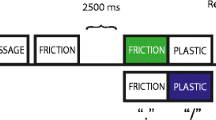Abstract
Order judgements are slower and less accurate when reversed. That is, when participants see two events in a sequence (e.g., circle …square), they are quicker to report ‘Before’ statements (e.g., “Circle before Square”) than ‘After’ statements (“Square after Circle”). The current study sought to determine whether a reversal effect will also occur when participants are instructed to produce a sequence of responses. Twenty participants were trained to criterion on simple ‘Before’ and ‘After’ instructions that specified sequences of two responses (e.g., “Circle before Square”). In a subsequent test, participants produced instructed sequences (e.g., circle … square) more quickly and more reliably when instructed to choose one stimulus before another than when they were requested to choose one stimulus after another. The implications of these findings for current theories of relational responding are considered.


Similar content being viewed by others
References
Andrews, G., & Halford, G. S. (2002). A cognitive complexity metric applied to cognitive development. Cognitive Psychology, 45, 153–219.
Beaman, C. P., & Morton, J. (2000). The separate but related origins of the recency and the modality effect in free recal. Cognition, 77, 59–65.
Cerutti, D. T. (1989). Discrimination theory of rule-governed behavior. Journal of the Experimental Analysis of Behavior, 51, 259–276.
Clark, E. (1971). On the acquisition of the meaning of before and after. Journal of Verbal Learning and Verbal Behavior, 10, 266–275.
Dermer, M. L., & Rogers, J. G. (1997). Schedule control over following instructions comprised of novel combinations of verbal stimuli. The Psychological Record, 47, 243–260.
Ebbinghaus, H. (1964/1885). Memory: A Contribution to Experimental Psychology. New York: Dover.
Hall, J. W., Sekuler, R., & Cushman, W. (1969). Effects of IAR occurrence during learning on response time during subsequent recignition. Journal of Experimental Psychology, 79, 39–42.
Hayes, S. C., & Hayes, L. J. (1989). The verbal action of the listener as a basis for rule- governance. In S. C. Hayes (Ed.), Rule-governed behavior: Cognition, contingencies, and instructional control (pp. 153–190). New York: Plenum.
Hayes, L. J., Thompson, S., & Hayes, S. C. (1989). Stimulus equivalence and rule following. Journal of the Experimental Analysis of Behavior, 52, 275–291.
Hayes, S. C., Barnes-Holmes, D., & Roche, B. (2001). Relational frame theory: A post-Skinnerian account of human language and cognition. New York: Plenum Press.
Hull, C. L. (1932). The goal gradient hypothesis and maze learning. Psychological Review, 39, 25–43.
Hyland, J. M., O’ Hora, D. P., Leslie, J. C., & Smyth, S. (2012). Sequential responding in accordance with temporal relational cues: a comparison of before and after. The Psychological Record, 62(3), 463–484.
Microsoft. (1998). Visual Basic Version 6.
O’Hora, D., Roche, B., Barnes-Holmes, D., & Smeets, P. M. (2002). Response latencies to multiple derived stimulus relations: testing two predictions of relational frame theory. The Psychological Record, 52, 51–75.
O'Hora, D., Barnes-Holmes, D., Roche, B., & Smeets, P. (2004). Derived relational networks as novel instructions: a possible model of generative verbal contro. The Psychological Record, 54, 437–460.
Skiljan, I. (2007). IrfanView. Retrieved from http://www.irfanview.com.
Skinner, B. F. (1969). Contingencies of Reinforcement. New Jersey: Prentice-Hall.
Steele, D. L., & Hayes, S. C. (1991). Stimulus equivalence and arbitrarily applicable relational responding. Journal of the Experimental Analysis of Behavior, 56, 519–555.
Author information
Authors and Affiliations
Corresponding author
Rights and permissions
About this article
Cite this article
Hyland, J.M., Smyth, S., O’Hora, D.P. et al. The Effect of Before and After Instructions on the Speed of Sequential Responding. Psychol Rec 64, 311–319 (2014). https://doi.org/10.1007/s40732-014-0026-y
Published:
Issue Date:
DOI: https://doi.org/10.1007/s40732-014-0026-y




